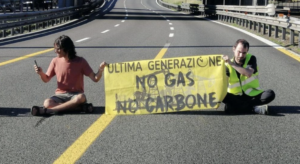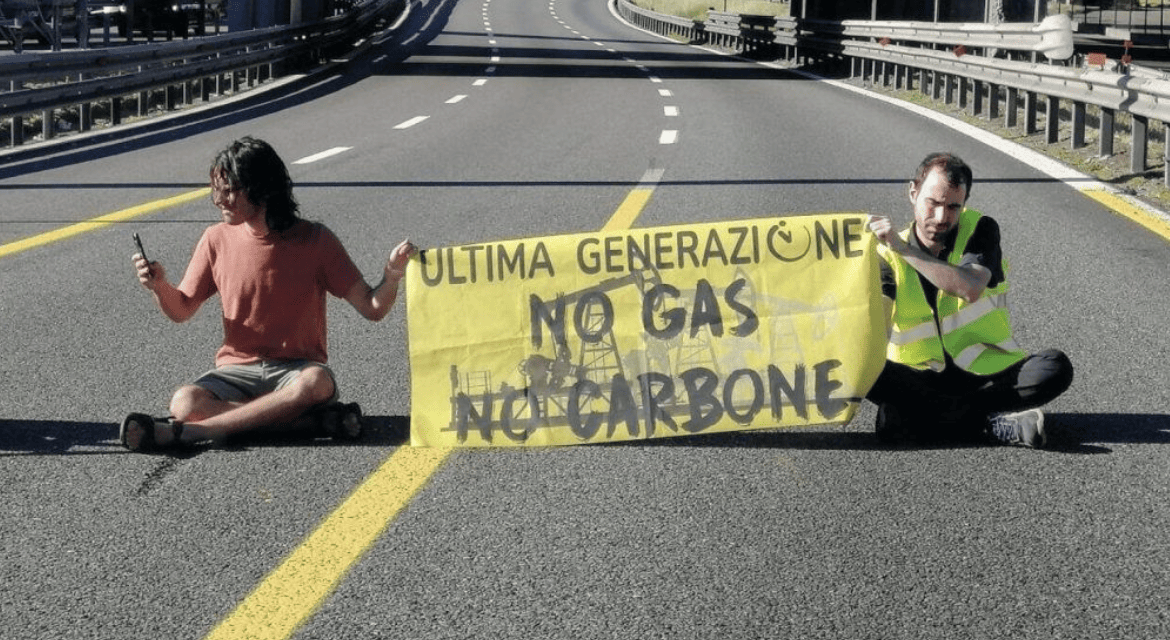
https://www.ilmillimetro.it/le-nostre-interviste-ultima-generazione/
Regularly, Italian drivers find themselves stuck. Doctors rushing to hospitals, parents escorting their children to school, students hurrying to class — all find themselves halted. Yet, Ultima Generazione refuses to yield: they sit amidst overcrowded roads, chaining together and displaying banners bearing emblematic messages, swaying while their demands stall traffic. Whether in Rome, Turin, or Milan, these protesters remain unmoving, almost resembling Marina Abramović in Rhythm 0. They are undeterred by irate drivers’ threats, frustrated workers and even the police. But why? Who are they, and what do they want? Most importantly, What do Ultima Generazione’s protests reveal about how we express our intolerance and demand change today?
Ultima Generazione (Last Generation) is an Italian civil disobedience campaign. It’s a non-violent collective, employing audacious actions to capture media attention, influence political figures, and alter public opinion on the eco-climate crisis. Their primary goal is to secure negotiations with the government. This aims at pressing for investments in renewable energy, halting gas extraction drilling, and preventing the resurgence of coal-fired plants.
Emerging in Italy in October 2021 from the initiative of six Extinction Rebellion activists disenchanted by the international movement’s bureaucratic standstill, this movement’s renowned actions include hunger strikes, roadblocks, splattering washable paint and flour on artworks, and painting public buildings such as Teatro alla Scala or the Love sculpture in Piazza Affari in Milan. Unlike movements such as Fridays For Futures and Extinction Rebellion, Ultima Generazione employs civil disobedience to contribute to a shared objective — a strategy that is also beginning to permeate less confrontational organizations. Comparing it with other protests, one understands that Ultima Generazione holds several methodological resemblances to trade unions, employing a classic confrontational scheme where disruptive and paralyzing non-violent actions aim to draw attention and exert pressure on power centers.
“As long as breath lingers in our bodies, we’ll persist,” proclaims their movement’s website. “We are Ultima Generazione. But we’re also the first. We’re omnipresent. We’re coming.” There’s a tinge of Gramscian essence in their resolute yet non-desperate revolutionary endeavor: the optimism of will.
The pressing question emerges: does their disruptive “modus operandi” prove effective? Using the example of Ultima Generazione’s protests is useful for a larger reflection. How does one protest? What are the protests that are still remembered today? And most importantly, what is the real impact of protests on actually changing things that seem intolerable and unchangeable?
Understanding this requires a comparison with other successful and unsuccessful protests. Specifically, one might remember the recent Just Stop Oil protest. Protestants caught the eye of the media in particular after throwing tomato soup at Vincent van Gogh’s Sunflowers at the National Gallery in London. The act might seem ridiculous, yet here we are discussing it: these protests achieved the attention they aimed for. Their approach required an institutional backdrop, akin to Richardson slashing Velàzquez’s Rokeby Venus or the Guerrilla Girls employing shocking graphics to protest institutional inequality.
Similarly, in contemporary popular culture, the very gesture of throwing paint at Van Gogh’s Sunflowers has become so well known that the protest and its gesture are often linked to the despair and frustration caused by the widely recognized climate collapse and pressing environmental crisis..
However, did the “Just Stop Oil” protest effectively highlight the oil problem? Global media attention focused on the activists rather than the issue they aimed to highlight. Revolutionary activism has proven successful before, but all the triumphant cases managed to spotlight the actual cause they advocated for in the media, not merely their method of operation. One cannot speak of Rosa Parks without addressing the rights of black people to sit wherever they please, same with the Liberate Tate group. Their objectives were intrinsic to their actions.
Protests operate as “societal stages,” employing dramatic gestures and striking visuals to command attention. Movements like Ultima Generazione epitomize this contemporary drama, using bold actions to spotlight their causes. However, the theatrics risk overshadowing the core purpose: enacting real change.
When protests become more spectacle than substance, the crucial message often gets drowned out. The focus shifts to the dramatic displays — the roadblocks, the eye-catching visuals — while the underlying message struggles to maintain attention. While spectacle may draw immediate attention, it’s the substantive message and sustained action that foster lasting impact.
Ultima Generazione, Just Stop Oil, and similar movements cause us to ask a question: what is the purpose of a protest? What’s certain is that it cannot merely be the aim to shock.
Other posts that may interest you:
- The Trouble with ‘Ecocide’
- Carbon dioxide removal – hit or miss?
- Local Victories for Turkish Opposition — A Sign of Hope?
- Are France and Japan a Mismatch Made in Heaven?
- A Reflection on Dark Tourism
Discover more from The Sundial Press
Subscribe to get the latest posts sent to your email.





